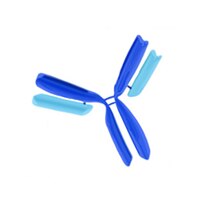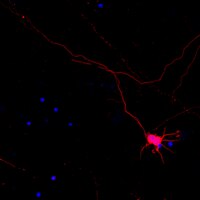Striatal astrocytes act as a reservoir for L-DOPA.
Asanuma, M; Miyazaki, I; Murakami, S; Diaz-Corrales, FJ; Ogawa, N
PloS one
9
e106362
2014
Mostra il sommario
L-DOPA is therapeutically efficacious in patients with Parkinson's disease (PD), although dopamine (DA) neurons are severely degenerated. Since cortical astrocytes express neutral amino acid transporter (LAT) and DA transporter (DAT), the uptake and metabolism of L-DOPA and DA in striatal astrocytes may influence their availability in the dopaminergic system of PD. To assess possible L-DOPA- and DA-uptake and metabolic properties of striatal astrocytes, we examined the expression of L-DOPA, DA and DAT in striatal astrocytes of hemi-parkinsonian model rats after repeated L-DOPA administration, and measured the contents of L-DOPA, DA and their metabolite in primary cultured striatal astrocytes after L-DOPA/DA treatment. Repeated injections of L-DOPA induced apparent L-DOPA- and DA-immunoreactivities and marked expression of DAT in reactive astrocytes on the lesioned side of the striatum in hemi-parkinsonian rats. Exposure to DA for 4h significantly increased the levels of DA and its metabolite DOPAC in cultured striatal astrocytes. L-DOPA was also markedly increased in cultured striatal astrocytes after 4-h L-DOPA exposure, but DA was not detected 4 or 8h after L-DOPA treatment, despite the expression of aromatic amino acid decarboxylase in astrocytes. Furthermore, the intracellular level of L-DOPA in cultured striatal astrocytes decreased rapidly after removal of extracellular L-DOPA. The results suggest that DA uptaken into striatal astrocytes is rapidly metabolized and that striatal astrocytes act as a reservoir of L-DOPA that govern the uptake or release of L-DOPA depending on extracellular L-DOPA concentration, but are less capable of converting L-DOPA to DA. | Immunohistochemistry | | 25188235
 |
Neurotoxic effect of the herbicide paraquat on ascidian larvae.
Giuliana Zega,Simona Candiani,Silvia Groppelli,Fiorenza De Bernardi,Roberta Pennati
Environmental toxicology and pharmacology
29
2009
Mostra il sommario
Paraquat is an herbicide widely used in agriculture, that proved to have toxic effect on many animal models. Moreover, it is considered a potential etiologic factor of Parkinson's disease. Ascidians are invertebrate chordates, whose larval central nervous system shares basic structural homologies with the vertebrate one. Ascidian larvae exposed to paraquat developed specific alterations of the CNS, that were characterized by histological and immunohistochemical analysis. Tyrosine hydroxylase (TH) expression was examined by in situ hybridization. A decrease of dopamine content in anterior CNS of treated larvae was observed. In combined treatments with paraquat and l-ascorbic acid, a common anti-oxidant, the severity of the malformations was significantly reduced, confirming that the oxidative stress is involved in the toxicity mechanism of paraquat on ascidians. For its sensitivity to paraquat and its simple chordate body plan, ascidian larva is a promising animal model to further investigate the molecular mechanism of paraquat neurotoxicity. | | | 21787578
 |
7-nitroindazole attenuates 6-hydroxydopamine-induced spatial learning deficits and dopamine neuron loss in a presymptomatic animal model of Parkinson's disease.
Kristi L Haik, Deborah A Shear, Chad Hargrove, Jared Patton, Michelle Mazei-Robison, Michael I Sandstrom, Gary L Dunbar
Experimental and clinical psychopharmacology
16
178-89
2008
Mostra il sommario
Parkinson's disease (PD) is a neurodegenerative disorder in which loss of dopaminergic (DA) neurons (>50%) in the substantia nigra (SN) precedes most of the overt motor symptoms, making early diagnosis and treatment interventions difficult. Because PD has been associated with free radicals generated by nitric oxide, this study tested whether treatments of 7-nitroindazole (7NI), a nitric-oxide-synthase inhibitor, could reduce cognitive deficits that often emerge before overt motor symptoms in a presymptomatic rat model of PD. Rats were given intraperitoneal injections of 50 mg/kg 7NI (or vehicle) just before receiving bilateral, intrastriatal injections of the DA-toxin, 6-hydroxydopamine (6-OHDA). The rats were then given a battery of motor tasks, and their learning ability was assessed using a spatial reversal task in a water-T maze. Results indicate that 7NI treatments attenuate 6-OHDA-induced spatial learning deficits and protect against DA cell loss in the SN, suggesting that 7NI may have potential as an early, presymptomatic pharmacotherapy for PD. | | | 18489022
 |
Constant illumination causes spatially discrete dopamine depletion in the normal and degenerate retina.
A A Vugler, P Redgrave, N J Hewson-Stoate, J Greenwood, P J Coffey
Journal of chemical neuroanatomy
33
9-22
2007
Mostra il sommario
A fully competent retinal dopamine system underpins normal visual function. Although this system is known to be compromised both prior to and during retinal degeneration, the spatial dynamics of dopamine turnover within the degenerate retina are at present unknown. Here, using immunohistochemistry for dopamine in combination with quantitative optical density measurements, we reveal a global decline in retinal dopamine levels in the light adapted RCS dystrophic rat, which is restricted to plexiform layers in the dark. Pharmacological blockade of dopamine production with the drug alpha-methyl-p-tyrosine (AMPT) allows the direct visualisation of dopamine depletion in normal and degenerate retina in response to constant illumination. In normal retinae this effect is spatially discrete, being undetectable in perikarya and specific to amacrine cell fibres in sublamina 1 of the inner plexiform layer. A similar response was observed in the retinae of dystrophic rats but with a reduction in amplitude of approximately 50%. It is suggested that the pattern of dopamine depletion observed in rat retina may reflect an AMPT-resistant pool of perikaryal dopamine and/or a reduction in extrasynaptic release of this neurotransmitter in response to illumination in vivo. We conclude that the visualisation of dopamine depletion reported here represents a release of this neurotransmitter in the response to light. Turnover of dopamine in the dystrophic retina is discussed in the context of surviving photoreceptors, including the intrinsically photosensitive melanopsin ganglion cells of the inner retina. | | | 17223011
 |
Dopamine and serotonin modulate the onset of metamorphosis in the ascidian Phallusia mammillata.
Giuliana Zega, Roberta Pennati, Silvia Groppelli, Cristina Sotgia, Fiorenza De Bernardi
Developmental biology
282
246-56
2004
Mostra il sommario
Neurotransmitters play an important role in larval metamorphosis in different groups of marine invertebrates. In this work, the role of dopamine and serotonin during metamorphosis of the ascidian Phallusia mammillata larvae was examined. By immunofluorescence experiments, dopamine was localized in some neurons of the central nervous system and in the adhesive papillae of the larvae. Dopamine and serotonin signaling was inhibited by means of antagonists of these neurotransmitters receptors (R(+)-SCH-23390, a D(1) antagonist; clozapine, a D(4) antagonist; WAY-100635, a 5-HT(1A) antagonist) and by sequestering the neurotransmitters with specific antibodies. Moreover, dopamine synthesis was inhibited by exposing 2-cell embryos to alpha-methyl-l-tyrosine. Dopamine depletion, obtained by these different approaches, caused early metamorphosis, while serotonin depletion delayed the onset of metamorphosis. The opposite effects were obtained using agonists of the neurotransmitters: lisuride, a D(2) agonist, inhibited metamorphosis, while DOI hydrochloride and 8-OH-DPAT HBr, two serotonin agonists, promoted it. So, it is possible to suppose that dopamine signaling delayed metamorphosis while serotonin signaling triggers it. We propose a mechanism by which these neurotransmitters may modulate the timing of metamorphosis in larvae. | | | 15936344
 |
Estrogen protects against the synergistic toxicity by HIV proteins, methamphetamine and cocaine.
Turchan, J; Anderson, C; Hauser, KF; Sun, Q; Zhang, J; Liu, Y; Wise, PM; Kruman, I; Maragos, W; Mattson, MP; Booze, R; Nath, A
BMC neuroscience
2
3
2001
Mostra il sommario
Human immunodeficiency virus (HIV) infection continues to increase at alarming rates in drug abusers, especially in women. Drugs of abuse can cause long-lasting damage to the brain and HIV infection frequently leads to a dementing illness. To determine how these drugs interact with HIV to cause CNS damage, we used an in vitro human neuronal culture characterized for the presence of dopaminergic receptors, transporters and estrogen receptors. We determined the combined effects of dopaminergic drugs, methamphetamine, or cocaine with neurotoxic HIV proteins, gp120 and Tat.Acute exposure to these substances resulted in synergistic neurotoxic responses as measured by changes in mitochondrial membrane potential and neuronal cell death. Neurotoxicity occurred in a sub-population of neurons. Importantly, the presence of 17beta-estradiol prevented these synergistic neurotoxicities and the neuroprotective effects were partly mediated by estrogen receptors.Our observations suggest that methamphetamine and cocaine may affect the course of HIV dementia, and additionally suggest that estrogens modify the HIV-drug interactions. | Immunofluorescence | Human | 11252157
 |
Neuronal release of endogenous dopamine from corpus of guinea pig stomach.
K Shichijo, Y Sakurai-Yamashita, I Sekine, K Taniyama
The American journal of physiology
273
G1044-50
1997
Mostra il sommario
Neuronal release of endogenous dopamine was identified in mucosa-free preparations (muscle layer including intramural plexus) from guinea pig stomach corpus by measuring tissue dopamine content and dopamine release and by immunohistochemical methods using a dopamine antiserum. Dopamine content in mucosa-free preparations of guinea pig gastric corpus was one-tenth of norepinephrine content. Electrical transmural stimulation of mucosa-free preparations of gastric corpus increased the release of endogenous dopamine in a frequency-dependent (3-20 Hz) manner. The stimulated release of dopamine was prevented by either removal of external Ca2+ or treatment with tetrodotoxin. Dopamine-immunopositive nerve fibers surrounding choline acetyltransferase-immunopositive ganglion cells were seen in the myenteric plexus of whole mount preparations of gastric corpus even after bilateral transection of the splanchnic nerve proximal to the junction with the vagal nerve (section of nerves between the celiac ganglion and stomach). Domperidone and sulpiride potentiated the stimulated release of acetylcholine and reversed the dopamine-induced inhibition of acetylcholine release from mucosa-free preparations. These results indicate that dopamine is physiologically released from neurons and from possible dopaminergic nerve terminals and regulates cholinergic neuronal activity in the corpus of guinea pig stomach. | Immunohistochemistry (Tissue) | Guinea Pig | 9374701
 |
Expression of c-ErbB2 in human neuroblastoma tissues, adrenal medulla adjacent to tumor, and developing mouse neural crest cells.
Goji, J; Nakamura, H; Ito, H; Mabuchi, O; Hashimoto, K; Sano, K
The American journal of pathology
146
660-72
1994
Mostra il sommario
We have examined the expression of c-ErbB2 in primary neuroblastoma tissues, mouse neural crest-derived tissues, and human adrenal gland adjacent to neuroblastoma tissue and of age-matched controls. c-ErbB2 expression was observed in approximately 60% of cases analyzed, and there were two staining patterns; one showed focal and cytoplasmic and the other showed diffuse and membrane staining patterns. The expression of c-ErbB2 in neuroblastoma tissues was confirmed by reverse transcription polymerase chain reaction and Western blot analysis. Diffuse and membrane staining of c-ErbB2 was well correlated with high urinary catecholamine secretion. In mouse tissues, cytoplasmic expression of c-ErbB2 was observed in immature peripheral neurons and adrenomedullary cells. In mature neurons, the immunoreactivity was confined to the plasma membrane. These results suggest that the expression of c-ErbB2 in neuroblastoma reflects the phenotype of developing peripheral neurons. Postnatal human and mouse adrenomedullary cells lacked c-ErbB2 immunoreactivity, although apparently normal adrenomedullary cells adjacent to neuroblastoma tissues showed strong cytoplasmic expression of c-ErbB2. It is not known whether the phenotypic conversion of adjacent adrenal medullary cells had occurred before or after tumor progression at present. | | | 7887448
 |
Modulation of lamprey fictive swimming and motoneuron physiology by dopamine, and its immunocytochemical localization in the spinal cord.
McPherson, DR, & Kemnitz, CP.
Neurosci. Lett., 166(1):23-26 (1994)
1993
| | | 8190353
 |
Cerebrospinal fluid antibodies: an indicator for immune responses in Alzheimer's disease.
Mcrae, A., Dahistrom, A.
Res Immunol., 143(6):663-667 (1992)
1992
| | | 1455058
 |


















